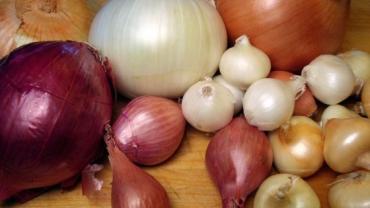
Onions: people love them or hate them. Or maybe they just hate the tears they cause while being chopped in the kitchen and hate the bad breath that sometimes lingers for hours after eating them. Onions certainly seem to give us reasons not to consume them. On the other hand it’s difficult to imagine good cuisine without them. There’s French onion soup onions grilled with meat on skewers for shish-ke-babs the classic mirepoix as the aromatic base for hundreds of dishes and an endless array of other applications for the myriad varieties of onions that are cultivated or grow in the wild.
Beyond eating them some people swear by home remedies that call for slipping a cut onion into a sock and wearing it on the foot to ward off colds and other illnesses. While this “old wives tale” method is unlikely to yield significant results it is true that consuming onions may have dramatic benefits for health.
Owing to the worldwide popularity of onions annual cultivation exceeds 44 million tons and onions are the second most important horticultural crop after tomatoes. (That’s a lot of onion breath!) In terms of nutrition onions aren’t exactly loaded with vitamins and minerals. They’re a good source of vitamin C and they have small amounts of B6 and manganese. Beyond that they don’t boast much with regard to required nutrients. For other helpful compounds though onions are rock stars.
As members of the Allium genus—a category that also includes garlic chives leeks scallions and shallots—onions are rich in sulfur and this sulfur may be responsible for many of onions’ health-promoting properties not unlike the sulfur-containing compounds in cruciferous vegetables such as broccoli and cabbage. It’s worth noting that the bitter flavor and “stinging” sensation of these foods are precisely what underlies their beneficial biological activity. Some scientists even call it “chemical warfare.”
Different types of onions contain different phytochemicals. For example red onions contain anthocyanins the compound responsible for their red/purple pigment (also found in raspberries blackberries and other similarly colored produce). Red onions are also a rich source of quercetin a compound that may have beneficial effects for heart health. Yellow and white onions also contain quercetin but in lower amounts. All onions have a significant amount of beneficial flavonols but these are more highly concentrated in red onions than in yellow. Fortunately these helpful compounds are heat-stable and their antioxidant properties are not lost during digestion. (Good to know for those who prefer not to eat raw onions!)
Onions have been studied extensively regarding compounds they contain that may have cancer-protective properties stemming from their sulfur content. Selenium is another nutrient that is believed to contribute to this effect. Not all onions are high in selenium however. Onions are known to accumulate selenium but this requires that the soil they’re grown in is rich in this element to begin with. High-selenium onions (as well as garlic and broccoli) may play a role in some small way in influencing cancerous tissue by interfering with cell growth and division and influencing apoptosis which can be thought of as a “self-destruct” mode for old and/or damaged cells. (Cancerous cells typically bypass this mechanism.)
Compounds in onions also influence the synthesis of eicosanoids and prostaglandins which are compounds that help regulate a healthy inflammatory response. For this reason onions have been recognized as having anti-clotting and anti-arthritic properties. As if all that weren’t enough onions may also be beneficial for reducing post-meal blood glucose spikes in those with type-2 diabetes. Compounds in onions inhibit some of the carbohydrate-digesting enzymes in the small intestine and they also help to normalize the activity of liver enzymes involved in regulating blood glucose levels. Of course this isn’t a reason to eat unlimited amounts of carbohydrate and just add some onion; it’s simply information for individuals who may be following very low-carbohydrate diets for blood sugar management but who are fearful of consuming onions because they’re slightly higher in carbs than something like say spinach. On the spectrum of carbohydrate-containing foods onions are a world apart from donuts!
Here’s a handy guide to the various types of onions and how to employ the best attributes of each while cooking along with a demonstration of a quick and easy way to chop an onion. Whether onions are grilled and served on top of a burger or served raw in garden-fresh salsa eating something healthful never tasted so good!
Sources